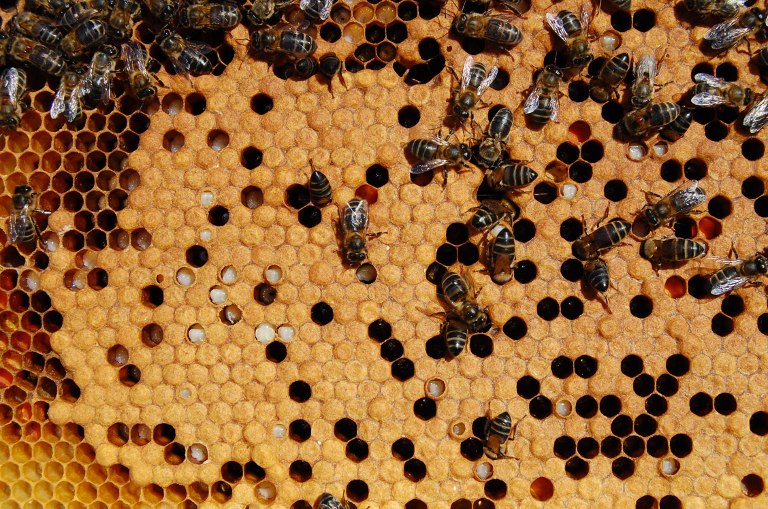how
does the small bee defend herself against the varroa mites?
People
asked me what is bald headed brood?
There are different ways that the bees defend against the varroa mites.
There are hives where the mites simply do not reproduce (SMR) like in
the african bee, there are
hives that do no let bees enter that carry a mite on her body and there
are hives that
cull out the varroa infested brood.
I will talk about the last way to defend.
In the small cell hives the mites concentrate in spring and summer in
the drone brood.
The drones are extremly important for the health of the hives.
They attract in these seasons all the diseases on themselves in order
to
avoid problems for the worker bees - they are like a living liver of the
hive.
I remind you that we have to cull all the frames that have more than
10% of drone brood.
These frames we put to the sides and then up with honey and out.
If not, the mites will reproduce too much.
We have to teach our bees not to raise too much drone brood. In the 100
years of using
foundation they have forgotten this very important behavior.
If we put a empty frame with only a wax strip above in a normal hive,
the bees will
probably raise all the frame of drone brood.
But with the pressence of the varroa mites this behavior is mortal.
When the hive in the end of summer and autumn do not raise so much drones
anymore, the
varroa mites have to move to the workerbrood. But they do not like it
at all, because they cannot reproduce
there. One mite in one out! But now they have no other option.
In this season the worker bees have more free time, because there is not
so much nectar to gather
and therefore they start to clean the brood cells.
They detect the mites in the tapped cells, open the cell and if the mite
is upon the
head of the unborn bee, they bite her and she will die.
If the mite is on the bottom of the cell, they eat all the young bee to
get to the varroa and then also bite her.
This always happens when the young, unborn white bees have purplish eyes.
Look at the foto very thoroughly - you can see the open cells that are
called "baldheaded"
brood and you also can see eaten young bees in the cells and also a mite
on a half eaten young bee.

bigger image to see the baldheaded brood better:
http://www.lapalmamiel.com/a/cria_calva2.jpg
this is a foto taken from hive N° 131 in autumn 2006 after being infected
purposely
with very much mites of another colapsing hive in june 2006.
Now in summer 2007 I took 15 liters of honey from this hive, it has now
4 supers and
a lot of honey and pollen remained inside.
Some ideas how the cohabit of bees and mites is posible
The
asian bee apis cerana is a small bee.
The brood cycle of the big bee is 21 days - in the small bee it is one
day less.
So less daughters of the mites emerge fertilized.
The bees advance the mites.
The distance between the frames has to be 32mm instead of 37mm in the
big cell hives.
Because the cells are smaller, there are more cells pro surface and the
distance between the
frames is smaller, the temperature in the broodnest is higher.
But the mites do not like higher temperatures and have to go to the perifery
of the nest to
the drone brood.
A small cell comb Langstroth has 8600 cells, a big one only 7000.
a short history
in february of 2007 I brought 24 hives to the zone of las Brenas.
They did not had contact with varroa until this moment.
They got infected by the mites and there must have been crashed a lot
of hives nearby, because the infection was very very fast.
In end of june they did not raise much drones anymore and the mites concentrated
in
the remaining drone brood. I have seen up to 20 varroa in one drone cell:
http://www.lapalmamiel.com/a/varroa_zangano.JPG
Half of the hives already defend themselves in june.
I have seen baldheaded brood.
The most interesting was that I have seen drone cells with more than
20 mites inside, but getting putrified. Surley due to the bites and this
is a trap
for the mites. I do not know if they also die, but if not, they do not
multiplicate.
A big advantage.
Hive N° 134 got in touch with varroa for the first time in spring
2007.
The queen is daughter of hive N° 10R which is the hive that best works
the small cells.
In the end of june I saw very much varroa in the drone brood that is in
the corner of the frame.
They do not rear very much drones because the flow is over:
http://www.lapalmamiel.com/a/134_2.JPG
But in the worker brood I could not find any mite.
But there have to be some because I have seen some baldheaded brood there.
This means that the bees are yet busy in cleaning off the mites.
http://www.lapalmamiel.com/a/134_3.JPG
This means that the daughters of hive 10R, that best works the small cells,
begin to defend themselves against varroa within 4 months after the first
contact with the mites.